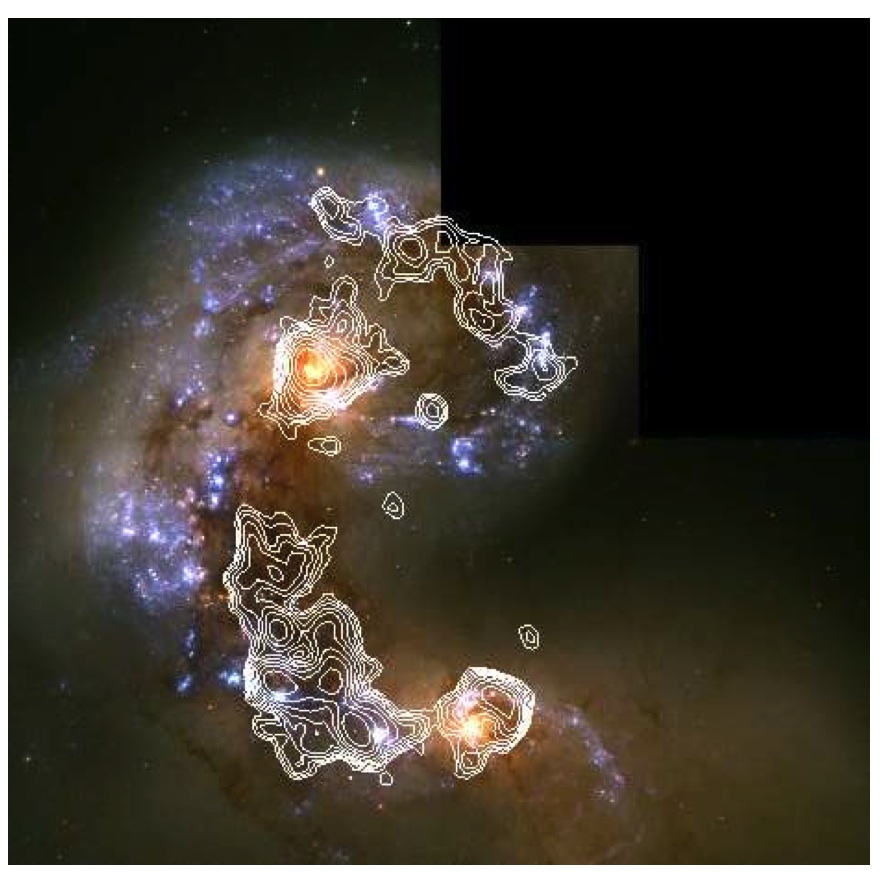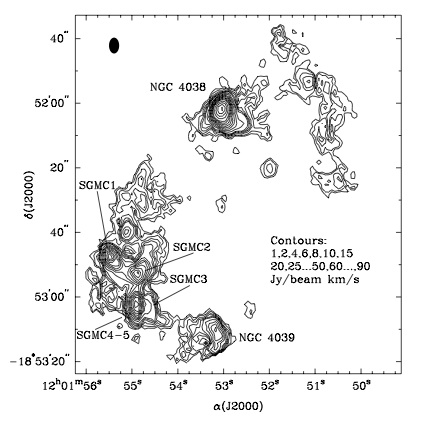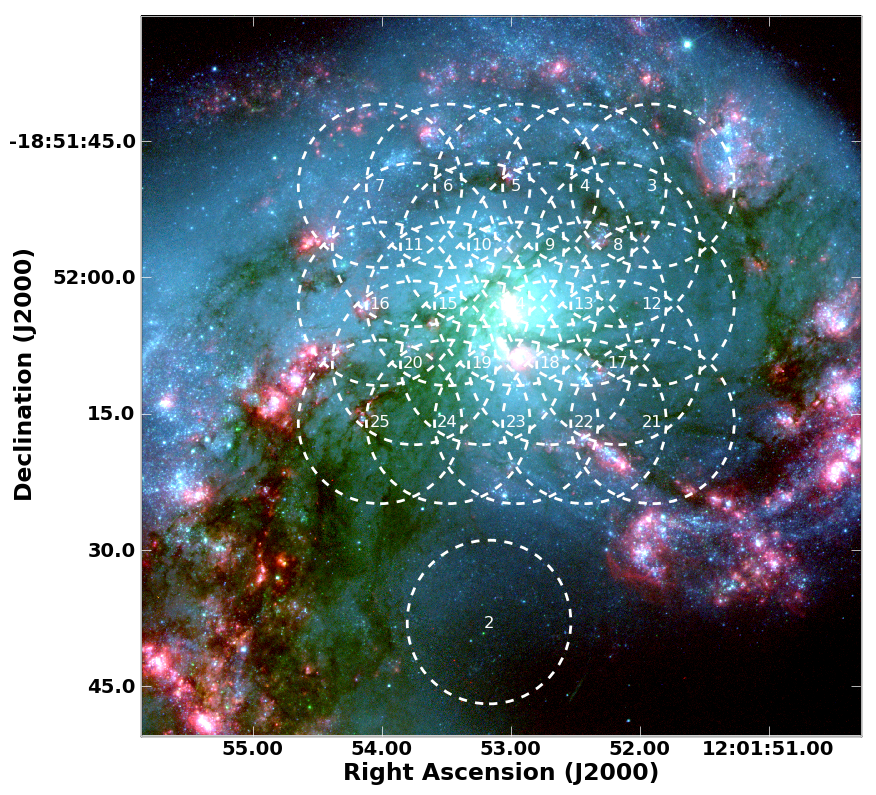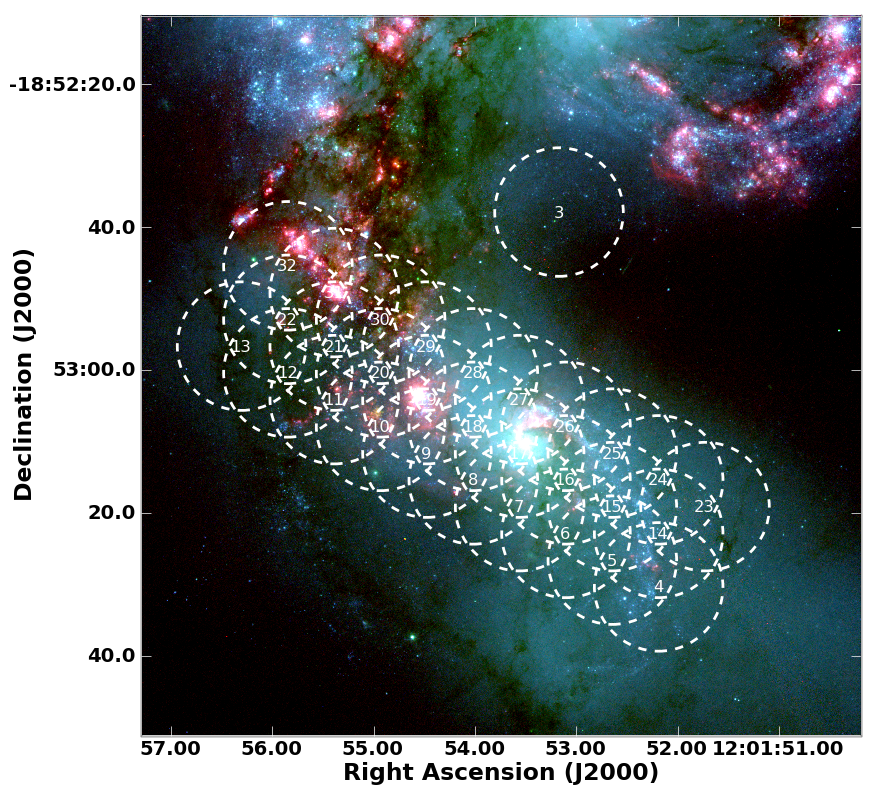AntennaeBand7 North SS12: Difference between revisions
No edit summary |
No edit summary |
||
| Line 3: | Line 3: | ||
[[Category:ALMA]][[Category:Calibration]][[Category:Spectral Line]] | [[Category:ALMA]][[Category:Calibration]][[Category:Spectral Line]] | ||
== Summer School Tutorial Overview == | |||
This is a temporary copy of the Antennae Band 7 CASA guide for use in the hands-on portion of the 13th Synthesis Imaging Summer School. In this tutorial, you will reduce science verification observations of the *Northern Antennae Mosaic*. The morning will be focused on calibration and the afternoon will be focused on imaging. This page gives an introduction to the target and scientific motivation for the observations. | |||
==Science Target Overview== | ==Science Target Overview== | ||
| Line 31: | Line 35: | ||
*uid://A002/X215db8/X392 | *uid://A002/X215db8/X392 | ||
*uid://A002/X215db8/X18 | *uid://A002/X215db8/X18 | ||
<pre style="background-color: #ffa07a;"> | |||
In order to ensure that you can work through the whole reduction in one morning, | |||
we focus the calibration guide on the first data set for the *Northern Mosaic*, "Xb" for short. We will provide all four *Northern Mosaic* calibrated data sets for imaging. | |||
</pre> | |||
The observations used two basebands, each associated with one spectral window (see the [https://almascience.nrao.edu/call-for-proposals/technical-guide ALMA Technical Handbook] for a discussion of the distinction between basebands and spectral windows). The baseband in the lower sideband (LSB) is centered on the CO (3-2) transition, and the baseband in the upper sideband (USB) is used to measure continuum emission. This guide will focus on the reduction of the LSB CO (3-2) data. Each sideband was observed in both a high spectral resolution "Frequency Domain Mode" (FDM) and a lower spectral resolution "Time Domain Mode" (TDM). We will focus on reducing the FDM data, which have an effective total bandwidth of 1.875 GHz (1634 km/s) divided over 3840 channels. The channel width in FDM mode is 488.28 kHz (0.426 km/s); because the data are automatically Hanning smoothed, the actual spectral resolution is twice this. The TDM mode data were observed and used mainly for calibration purposes; we will not directly analyze them in this CASA Guide, though we will use calibration products (system temperature measurements) derived from these data. | The observations used two basebands, each associated with one spectral window (see the [https://almascience.nrao.edu/call-for-proposals/technical-guide ALMA Technical Handbook] for a discussion of the distinction between basebands and spectral windows). The baseband in the lower sideband (LSB) is centered on the CO (3-2) transition, and the baseband in the upper sideband (USB) is used to measure continuum emission. This guide will focus on the reduction of the LSB CO (3-2) data. Each sideband was observed in both a high spectral resolution "Frequency Domain Mode" (FDM) and a lower spectral resolution "Time Domain Mode" (TDM). We will focus on reducing the FDM data, which have an effective total bandwidth of 1.875 GHz (1634 km/s) divided over 3840 channels. The channel width in FDM mode is 488.28 kHz (0.426 km/s); because the data are automatically Hanning smoothed, the actual spectral resolution is twice this. The TDM mode data were observed and used mainly for calibration purposes; we will not directly analyze them in this CASA Guide, though we will use calibration products (system temperature measurements) derived from these data. | ||
| Line 44: | Line 53: | ||
==Obtaining the Data== | ==Obtaining the Data== | ||
We have provided the data for you on the tutorial computers. The calibration and imaging portions of the guide will step you through how to get started. | |||
Once you return to your home institution, you may want to follow the full version of the CASA guide. In this case the data are available via the ALMA science portal [http://almascience.nrao.edu/almadata/sciver/Antennae here] . | |||
==Antennae Northern Mosaic Data Reduction Tutorial== | |||
The tutorial has two main parts. We will spend the morning on calibration of the data and then the afternoon imaging the calibrated data (and using these images to further refine the calibration). There is a separate page for each part of the tutorial: | |||
''' | # '''[[AntennaeBand7_North_Calibration_3.4]]''' this page steps you through the morning calibration tutorial. | ||
# '''[[AntennaeBand7_North_Imaging_3.4]]''' this page steps you through the afternoon imaging and self-calibration tutorial. | |||
==How to Use A CASA Guide== | ==How to Use A CASA Guide== | ||
Revision as of 17:04, 1 June 2012
- Calibration portion of the tutorial: AntennaeBand7 North Calibration 3.4
- Imaging portion of the tutorial: AntennaeBand7 North Imaging 3.4
Summer School Tutorial Overview
This is a temporary copy of the Antennae Band 7 CASA guide for use in the hands-on portion of the 13th Synthesis Imaging Summer School. In this tutorial, you will reduce science verification observations of the *Northern Antennae Mosaic*. The morning will be focused on calibration and the afternoon will be focused on imaging. This page gives an introduction to the target and scientific motivation for the observations.
Science Target Overview


The Antennae are a nearby (22 Mpc, Schweizer et al. 2008) pair of merging galaxies, NGC 4038 (RA 12h 01m 53.0s, Dec −18° 52′ 10″) in the north and NGC 4039 (RA 12h 01m 53.6s, Dec −18° 53′ 11″) in the south. These two spiral galaxies started to interact only a few hundred million years ago (Mihos et al. 1993), making the Antennae one of the nearest and youngest examples of a major galaxy merger. The yellow bright components to the south and north of the image center of Figure 1 correspond to the nuclei of the original galaxies and are composed mostly of old stars. Dust filaments, which appear brown in the image, pervade the region between the two nuclei, and star-forming regions surrounded by HII regions (blue) can be seen throughout the system. Wilson et al. (2000) used OVRO to map CO(1-0) emission, a tracer of the bulk molecular gas distribution, with a resolution of 3.15″ x 4.91″ (Figures 1 and 2). Molecular emission is detected throughout the system and is particularly bright in the "interaction region" between the two nuclei, where it appears concentrated in five supergiant molecular complexes (see Figure 2).
ALMA Data Overview


This CASA Guide steps through the reduction and imaging of ALMA Science Verification data targeting the CO 3-2 line in the Antennae galaxy. These data were obtained using the ALMA Band 7 receiver and observed in 10 separate blocks, each typically ~1 hour long, during May and June 2011. Each block observed one of two mosaic patterns, which we will refer to as the "Northern" and "Southern" mosaics. Figures 3 and 4 show the coverage of these two mosaics on an optical image of the Antennae. Within an individual observing block, the observations progress through individual pointings of the mosaic in rapid succession. One field was offset from the main body of the galaxy in each mosaic for calibration purposes.
The observations are broken down into ten individual data sets, as follows:
Northern mosaic (covering the nucleus of NGC 4038):
- uid://A002/X1ff7b0/Xb
- uid://A002/X207fe4/X3a
- uid://A002/X207fe4/X3b9
- uid://A002/X2181fb/X49
Southern mosaic (covering the nucleus of NGC 4039 and part of the interaction region):
- uid://A002/X1ff7b0/X1c8
- uid://A002/X207fe4/X1f7
- uid://A002/X207fe4/X4d7
- uid://A002/X215db8/X1d5
- uid://A002/X215db8/X392
- uid://A002/X215db8/X18
In order to ensure that you can work through the whole reduction in one morning, we focus the calibration guide on the first data set for the *Northern Mosaic*, "Xb" for short. We will provide all four *Northern Mosaic* calibrated data sets for imaging.
The observations used two basebands, each associated with one spectral window (see the ALMA Technical Handbook for a discussion of the distinction between basebands and spectral windows). The baseband in the lower sideband (LSB) is centered on the CO (3-2) transition, and the baseband in the upper sideband (USB) is used to measure continuum emission. This guide will focus on the reduction of the LSB CO (3-2) data. Each sideband was observed in both a high spectral resolution "Frequency Domain Mode" (FDM) and a lower spectral resolution "Time Domain Mode" (TDM). We will focus on reducing the FDM data, which have an effective total bandwidth of 1.875 GHz (1634 km/s) divided over 3840 channels. The channel width in FDM mode is 488.28 kHz (0.426 km/s); because the data are automatically Hanning smoothed, the actual spectral resolution is twice this. The TDM mode data were observed and used mainly for calibration purposes; we will not directly analyze them in this CASA Guide, though we will use calibration products (system temperature measurements) derived from these data.
When these observations were taken, the ALMA antennas were in a configuration that is intermediate between the Cycle 0 "Extended" and "Compact" configurations. We expect this configuration to yield an angular resolution of about 1 arcsecond near 345 GHz.
Using the data for publication: The following statement should be included in the acknowledgment of papers using the datasets listed above: “The Atacama Large Millimeter/submillimeter Array (ALMA), an international astronomy facility, is a partnership of Europe, North America and East Asia in cooperation with the Republic of Chile. This paper makes use of the following ALMA Science Verification data: ADS/JAO.ALMA#2011.0.00003.SV”
We thank the following people for suggesting NGC4038/9 for ALMA Science Verification: Francois Boulanger, Nicole Nesvadba, Cinthya Herrera. We particularly thank Christine Wilson and Junko Ueda for providing both the suggestions and the OVRO (CO(1-0): Wilson et al. 2000) and SMA (CO(3-2): Ueda et al., submitted) data for verification purposes.
Obtaining the Data
We have provided the data for you on the tutorial computers. The calibration and imaging portions of the guide will step you through how to get started.
Once you return to your home institution, you may want to follow the full version of the CASA guide. In this case the data are available via the ALMA science portal here .
Antennae Northern Mosaic Data Reduction Tutorial
The tutorial has two main parts. We will spend the morning on calibration of the data and then the afternoon imaging the calibrated data (and using these images to further refine the calibration). There is a separate page for each part of the tutorial:
- AntennaeBand7_North_Calibration_3.4 this page steps you through the morning calibration tutorial.
- AntennaeBand7_North_Imaging_3.4 this page steps you through the afternoon imaging and self-calibration tutorial.
How to Use A CASA Guide
For tips on using CASA and ways CASA can be run, see EVLA_Spectral_Line_Calibration_IRC+10216#How_to_Use_This_casaguide page.
To learn how to extract executable Python scripts from the tutorial, see Extracting_scripts_from_these_tutorials.
Within the guides:
# In CASA
Regions of this color are CASA commands (or definitions) that need to be cut and
pasted in sequence. Wait until one command is finished before pasting another.
Tabs matter in python, make sure that commands that span more than one line and
"for" loops keep their spacing. Sometimes (especially "for" loops) you may need to
explicitly hit enter twice to get the command going.
Information in this color shows excerpts from the CASA Logger output
This color shows you background information about the data or other types of reference material